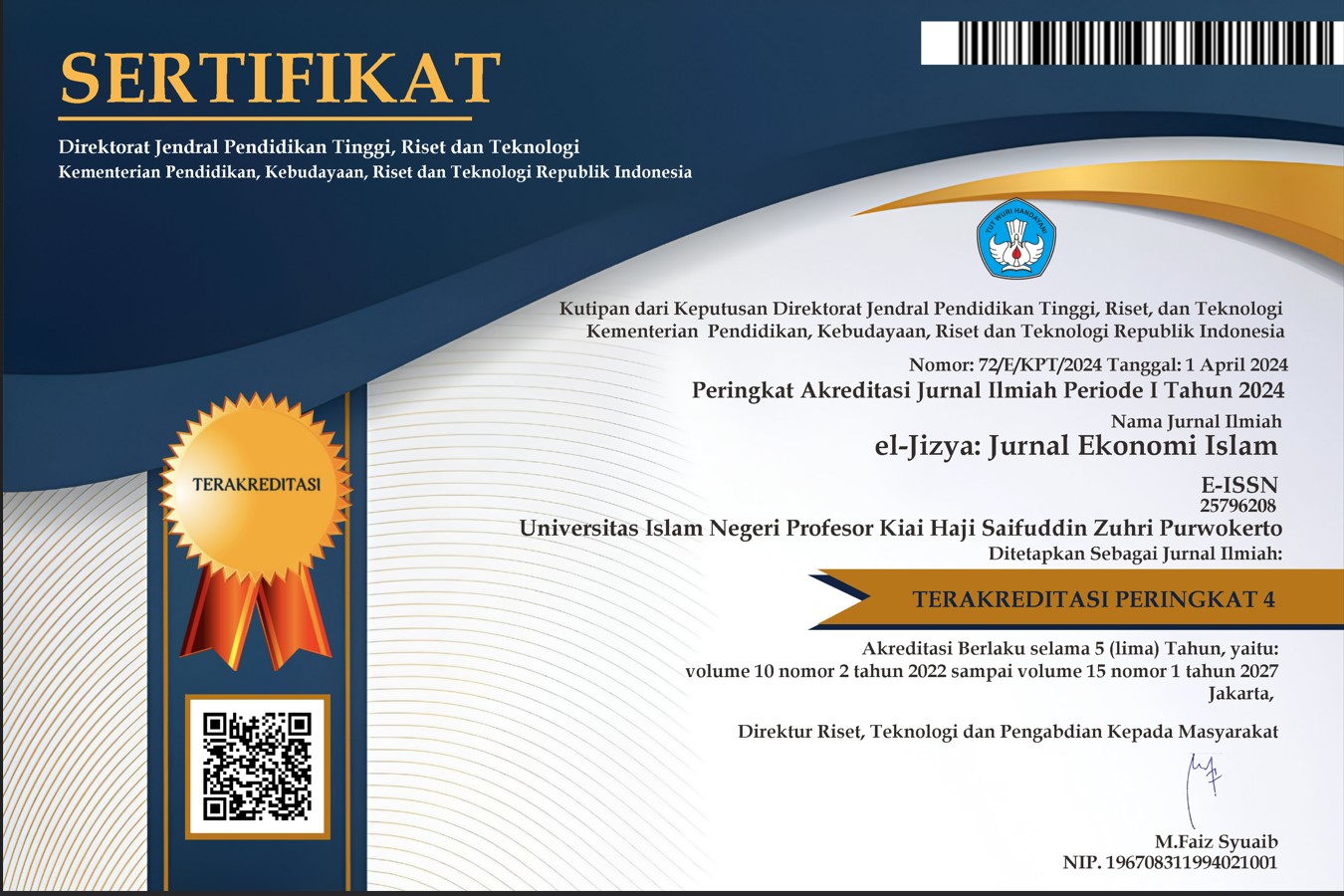Bibliometric Analysis of Islamic Banking Products in Encouraging the Finansial Inclusion in Indonesia
DOI:
https://doi.org/10.24090/ej.v12i2.12166Keywords:
Keywords: Islamic Finance, Financial Inclusion, Bibliometric Analysis, VOSviewerAbstract
In order to determine how well Islamic financial products promote financial inclusion in the society, this study performed a bibliometric examination of the literature on Islamic finance and financial inclusion. The scholarly literature is analyzed for trends, patterns, and study focus using a bibliometric technique. Information gathered from 920 publications that were mentioned over 568,52 times between 2010 and 2024 demonstrates the literature's major contribution to the growth of the Islamic finance sector. While citation analysis identifies the subjects receiving the greatest attention in the literature, network visualization of research themes and trends shows the progression of ideas from theoretical to practical applications. These results offer a clearer picture of the growth of the Islamic financial sector and the obstacles in the way of achieving greater financial inclusion in society. By delving further into the patterns and trends seen in scholarly works, practitioners and policymakers may create more effective plans to increase public access to Islamic financial services while adhering to Islamic principles.References
(CSIC), O. and S. R. G. (2016). Compendium of bibliometric science indicators. OECD, Paris, 66.
Amaroh, S. (2023). Sosialisasi Literasi Keuangan Syariah Pada Perempuan Pelaku Usahakonveksi Di Sentra Industri Padurenan Kudus. Reswara: Jurnal Pengabdian Kepada Masyarakat, 4(1), 151–161.
Anggadini, S. D. (2015). Mekanisme Pengawasan Dewan Pengawas Syariah Dan Bank Indonesia Terhadap Bank Syariah. Majalah Ilmiah UNIKOM, 12(1), 77–84. https://doi.org/10.34010/miu.v12i1.38
Aria, M. & C. C. (2022). Package ‘ bibliometrix ’ R topics documented :
Aripin, N. T., Fatwa, N., & Hannase, M. (2022). Layanan Digital Bank Syariah Sebagai Faktor Pendorong Indeks Literasi Dan Inklusi Keuangan Syariah. Syarikat: Jurnal Rumpun Ekonomi Syariah, 5(1), 29–45.
Aziz, A. A., Fitriyah, A. T., Bussiness, I., Negeri, U. I., Bussiness, I., & Negeri, U. I. (2024). Accepted Manuscript innovation Accepted Manuscript Pre-Proofs. Journal of Innovation in Business and Economics, 8(1), 18–35.
Faidah, F., Rini, G. P., & Marliana, E. (2020). Program pendampingan peningkatan literasi lembaga keuangan syariah pada masyarakat Desa Honggosoco. L Khidmat: Jurnal Ilmiah Pengabdian Kepada Masyarakat, 3(3).
Fatmawati, E. (2012). Pengantar Kajian Bibliometrika dalam Perspektif pustakawan. Jurnal Llmiah Kepustakawanan “Libraria,” 2(1), 1–17.
Glänzel, W. (2003). Bibliometrics as a research field. Techniques, 20, 2005.
Hakim, A. (2019). Peluang dan tantangan lembaga keuangan syariah Indonesia pada era pasar bebas ASEAN. Jurnal Keislaman, 2(2), 217–237.
Hanafi, S. M., Markarma, A., & Megandani, A. (2022). Sharia Financial Literature In Promoting Religious Moderation In Indonesia. Jurnal Lektur Keagamaan, 20(2), 413–444.
Haryani, C. S., & Sudin, A. (2020). Analisis Bibliometrik Tren Publikasi dan Tingkat Kolaborasi pada Model Situation-Based Learning (2010-2019). Jurnal Pena Ilmiah, 3(2), 131–140.
Hidayatullah, M. R., & Pratiwi, N. A. (n.d.). Manifestation of Sharia-based credit in its realization fulfilling needs using a credit system. Sebelas Maret Business Review, 7(1), 35–41.
Hodonu-Wusu, J. O., & Lazarus, G. N. (2018). Major trends in lis research: A bibliometric analysis. Library Philosophy and Practice.
Mujiatun, S. (2023). The Role Of The Community In Increasing Sharia Financial Literature And Inclussion. International Journal of Accounting & Finance in Asia Pasific (IJAFAP), 6(1), 1–11.
Muneeza, A., & Mustapha, Z. (2021). Islamic fintech and financial inclusion. Islamic FinTech: Insights and Solutions, 173–190.
Mustofa, U. (2020). Efektivitas Program Edukasi dan Religiositas Dalam Meningkatkan Literasi dan Inklusi Keuangan Syariah. Iqtisad: Reconstruction of Justice and Welfare for Indonesia, 7(2), 214–231.
Pamuji, A. E., & Supandi, A. F. (2021). Strategi Penguatan Industri Keuangan Syariah Di Era Mea. Finansha: Journal of Sharia Financial Management, 2(2), 92–107.
Pamuji, A. E., Supandi, A. F., & Sa’diyah, M. (2022). Islamic Financial Institutions as Strengthening The Economy of The Ummah (Study on The Application of Shariah Agreements in Islamic Financial Institutions). Islamic Financial Institutions as Strengthening The Economy of The Ummah (Study on The Application of Shariah Agreements in Islamic Financial Institutions), 7(1), 24–36.
Pratiwi, & L. (2019). Analisis Penanganan Pembiayaan Bermasalah Di Bni Syariah Kantor Cabang Surakarta Ditinjau Dari Peraturan Bank 10/18/Pbi/2008 Indonesia.
Rohman, A., & Syufaat, S. (2023). Perkembangan Industri Keuangan Syariah di Masa Pandemi Covid-19. Jurnal Hukum Ekonomi Syariah, 6(1), 31–42.
Royani, Y., & Idhani, D. (2018). Analisis Bibliometrik Jurnal Marine Research in Indonesia. Marine Research in Indonesia, 25(4), 63–68.
Sholiha, I. (2023). Telaah Ilmiah Industri Keuangan Non-Bank (Inbk) Syariah Dan Eksistensinya Di Indonesia Pasca Covid-19. Al-Idarah: Jurnal Manajemen Dan Bisnis Islam, 4(1), 1–25.
Sidiq, M. (2019). Panduan Analisis Bibliometrik Sederhana Universitas Negeri Jakarta. June. https://doi.org/10.13140/RG.2.2.15688.37125
Sodik, F., & Riza, A. F. (2023). Potensi QRIS M-banking Bank Syariah sebagai Teknologi Pembayaran untuk Mendukung Inklusi Keuangan Syariah di Indonesia. Jurnal Ekonomi Indonesia, 12(2), 125–154.
Syaichoni, A. (2020). Pengaruh literasi keuangan syariah terhadap consumer behavior mahasiswa. An-Nisbah: Jurnal Ekonomi Syariah, 7(1), 74–119.
Syarvina, W., Soemitra, A., & Nawawi, Z. (2023). Determinan Market Share Industri Keuangan Non Bank Syariah Indonesia. Jurnal Riset Akuntansi Dan Bisnis, 23(1), 24–34.
Syathiri, A., Asngari, I., Putri, Y. H., Widyanata, F., & Wahyudi, H. (2023). Peningkatan Literasi Keuangan Digital Syariah Bagi Siswa Sekolah Menengah Atas Raudhatul Ulum Desa Sakatiga Kecamatan Inderalaya Kabupaten Ogan Ilir. BEGAWI: Jurnal Pengabdian Kepada Masyarakat, 1(1), 17–20.
Toyyibi, A. M. (2021). Pemahaman Masyarakat Tentang Perbankan Syariah Melalui Keberadaan Lembaga Keuangan Syariah Di Era Industri 4.0. SAUJANA: Jurnal Perbankan Syariah Dan Ekonomi Syaria, 3(1), 33–40.
Trisela, I. P. &, & Pristiana, U. (2020). Analisis Perbandingan Kinerja Keuangan Bank Syariah Dengan Bank Konvensional Yang Terdaftar Di Bursa Efek Indonesia Periode 2014-2018. (pp. 83–106).
Tupan, T., Rahayu, R. N., Rachmawati, R., & Rahayu, E. S. R. (2018). Analisis Bibliometrik Perkembangan Penelitian Bidang Ilmu Instrumentasi. Baca: Jurnal Dokumentasi Dan Informasi, 39(2), 135. https://doi.org/10.14203/j.baca.v39i2.413
Visser, H. (2019). Islamic finance: Principles and practice. Edward Elgar Publishing.
Widiawati, W., Nuraini, A. N. A., & Haryana, A. H. A. (2022). Analysis of The Effect Of Sharia Financial Technology (Fintech) on Increasing Literacy and Inclusion of Sharia Financial Inclusion of Msmes in Dki Jakarta. Journal of Entrepreneur and Business, 1(1), 14–24.
Yuneline, M. H. (2022). Implications of Shariah Financial Technology in Increasing Financial Inclusion to Micro, Small, and Medium Enterprises. Islamiyyat, 44(1), 49–59.
Downloads
Published
How to Cite
Issue
Section
License
Copyright (c) 2024 Hendra Ramadan, Joko Setyono

This work is licensed under a Creative Commons Attribution-ShareAlike 4.0 International License.
Authors who publish with this journal agree to the following terms:
- Authors retain copyright and grant the journal right of first publication with the work simultaneously licensed under a Creative Commons Attribution-ShareAlike License that allows others to share the work with an acknowledgement of the work's authorship and initial publication in this journal.
- Authors are able to enter into separate, additional contractual arrangements for the non-exclusive distribution of the journal's published version of the work (e.g., post it to an institutional repository or publish it in a book), with an acknowledgement of its initial publication in this journal.
- Authors are permitted and encouraged to post their work online (e.g., in institutional repositories or on their website) prior to and during the submission process, as it can lead to productive exchanges, as well as earlier and greater citation of published work (See The Effect of Open Access).















